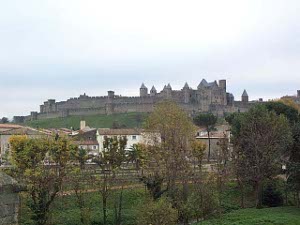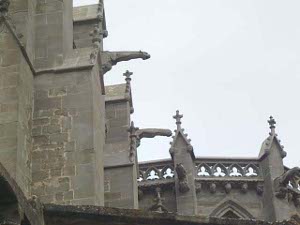We left early for Carcassonne. It was still dark as we walked to the train  Walled city upon a hill
station past a produce market just setting up for business on a wide street. The vegetables were arranged for best display, with red and green peppers next to purple eggplants, endives in a neat row, tomatoes improbably red. We imagined what it would look like with the street thronged with shoppers, and were glad we were ahead of the crowd.
Walled city upon a hill
station past a produce market just setting up for business on a wide street. The vegetables were arranged for best display, with red and green peppers next to purple eggplants, endives in a neat row, tomatoes improbably red. We imagined what it would look like with the street thronged with shoppers, and were glad we were ahead of the crowd.
We ate pastries and coffee on the train just like regular commuters, scattering flaky crumbs on the floor as the train pulled out of the station. We stopped at each station on the way to Carcassonne.
You can take a bus or taxi from the train station to the old city (La Cite) but the walk is just as easy. The present-day town was full of shops,  Entrance to the walled city
offices, restaurants and busy people, along with squares, fountains, parks and playgrounds. We headed for the old bridge.
Entrance to the walled city
offices, restaurants and busy people, along with squares, fountains, parks and playgrounds. We headed for the old bridge.
Suddenly, rounding a corner, we caught our breath as we saw the old double-walled city on top of a hill. We felt we'd been transported to the middle ages. Over the bridge and up the streets we left the sidewalk and took the dirt path to the entrance. A French national historic sight. You bet. The entrance is over a drawbridge, then through a large gate. It's like a storybook.
We got a map from the Tourist Office in the dungeon and then started walking around the city. The streets were nearly deserted -- off season and early in the morning at this famous tourist site. We were able to appreciate the architecture and the narrow curving streets at our leisure. We imagined it was centuries ago.
 Beautiful old street
Beautiful old street
We headed left for the square of the small well and then to the Gothic Basilica of Saint Nazaire, where we admired the shrine to Joan of Arc. In the churchyard is an amphitheater used for summer educational programs. We peeked between the double walls, where jousts were once held.
Just north of the church is the Place Auguste Pierre Pont, with a wonderful hotel and some ancient buildings, now stores and restaurants.
We continued north towards the castle -- the Chateau Comtal, where we encountered a tour group. Carcassonne is such a magnet for tourists that even in the off season there are groups. By now the shops were opening, too.  The large well
Michelin warns of the "attrape-tourist" businesses -- tourist traps. Of course our sales resistance is high, but we did manage to get some postcards for our snail mail friends.
The large well
Michelin warns of the "attrape-tourist" businesses -- tourist traps. Of course our sales resistance is high, but we did manage to get some postcards for our snail mail friends.
There are nice-looking hotels and restaurants within the walls, and, in summer, pageants and musical performances. We photographed the castle from all sides, the square of the large well, and the lovely views from the ramparts over the surrounding countryside.
But we declined the rare opportunity to visit the museum of dungeon torture, whose minions had set out glossy brochures all over, and whose barker,  Gargoyles on the basilica
sitting out front, called at us as we walked past!
Gargoyles on the basilica
sitting out front, called at us as we walked past!
Carcassonne's recorded history begins in Roman times. The town was occupied continually through sieges by the Visigoths and the Franks. Charlemagne besieged the town; the inhabitants were starving, according to the legend, when Dame Carcas, the widow of the commander of the town, scraped the last grains of corn from all the bins and fed it to a pig, then threw the pig over the walls. It burst open spilling the just-eaten corn. Charlemagne's troops decided that if they could spare corn for their animals they were still far from defeat, so they withdrew and the city was saved. Dame Carcas ordered the trumpets blown to summon Charlemagne to a conference: Carcas sonne (Carcas  Carcassonne buildings
is calling, in French). Thus the name of the city.
Carcassonne buildings
is calling, in French). Thus the name of the city.
By the 12th and 13th centures, the walls had been built to the stage we see today. Troubadors, knights and their ladies, the entire pageant of feudal and chivalric society flourished in Carcassonne. But the Albigensian Heresy was also flourishing in this region. This religious movement was a reaction against excesses of worldly life. In extreme cases people starved themselves to death, others gave up marriage and family life for a stict asceticism. They believed that the Roman Catholic church was created by the devil. This became such a popular belief that the Pope sent Dominican monks to lead the populace back to the church.
 The massive walls
The massive walls
Persuasion having failed, in 1208 the church sent a Crusade, led by Simon of Montfort, to stamp out the heretics. The crusade succeeded, the Albigensians were reconverted or killed, and the town was ruled by a succession of knights and warriors. Additional fortifications were built.
In 1659 Roussillon Province, which had formerly belonged to Spain, became part of France. No longer a critical border outpost, Carcassonne was neglected and the military contingents withdrawn. The city began a gentle decline. So it was falling into ruin by the 19th century, when the French government decided to restore it as a major historic monument. So today the traveller has a fine chance to visit and imagine, as we did, the days of chivalry and guilds.
 Walled city upon a hill
station past a produce market just setting up for business on a wide street. The vegetables were arranged for best display, with red and green peppers next to purple eggplants, endives in a neat row, tomatoes improbably red. We imagined what it would look like with the street thronged with shoppers, and were glad we were ahead of the crowd.
Walled city upon a hill
station past a produce market just setting up for business on a wide street. The vegetables were arranged for best display, with red and green peppers next to purple eggplants, endives in a neat row, tomatoes improbably red. We imagined what it would look like with the street thronged with shoppers, and were glad we were ahead of the crowd.
 Entrance to the walled city
Entrance to the walled city Beautiful old street
Beautiful old street The large well
The large well Gargoyles on the basilica
Gargoyles on the basilica Carcassonne buildings
Carcassonne buildings The massive walls
The massive walls